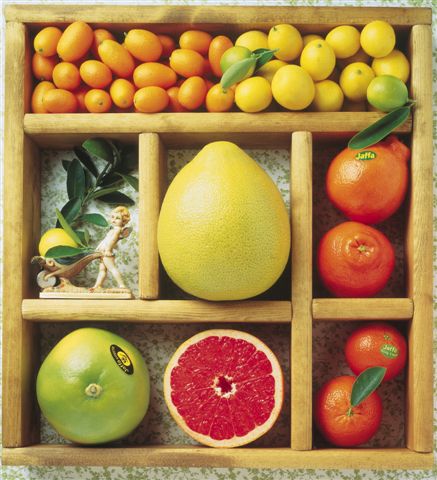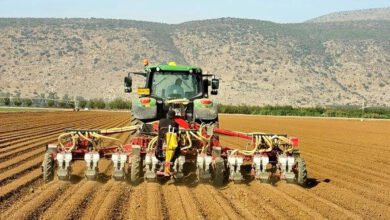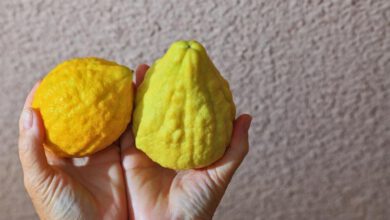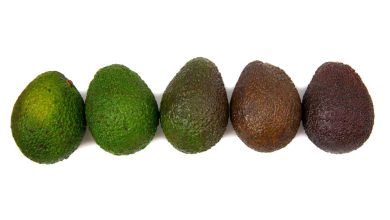The Citrus Fruit Industry in Israel
Tal Amit- The plantes Production and Marketing Board

General background:
The citrus industry in Israel owes its development to the growth of trade from the Far East to the “Old Continent”, namely Europe.
The Spanish and Portuguese seamen who plied those routes suffered from scurvy, a disease caused by a lack of vitamin C. When it was discovered that citrus fruit, which originated in China, was rich in vitamin C, the sailors began to take this fruit with them, but it rotted during these long journeys. To solve this problem citrus fruit trees were planted in the vicinity of the ports of call along the route where the ships would take on supplies and include citrus fruit. Jaffa was one of these ports of call en route from Europe to the East (prior to the opening of the Suez Canal a section of the journey was made overland). This led to the development of the citrus industry in Israel, once it quickly became evident that the climatic conditions and the soil there were ideally suited to the new crop.
The industry’s major drive forward began in the early nineteenth century, when a special type of citrus fruit was discovered in the groves of one of the Arab growers in Jaffa, and this fruit later became known as “Shamouti”, which over the year became a great success, and led to the industry’s rapid growth in Israel.
 |  |
 |  |
The citrus fruit’s growing regions and the size of those areas:
The history of the citrus fruit in Israel from its earliest days has been marked by frequent fluctuations, reflecting the political, climatic and general events in our region that also affected agriculture. Such notable episodes included the two world wars, the Great World War and especially the Second World War, as these events forced the industry to start almost from the very beginning, because during these lengthy conflicts the citrus groves were largely abandoned.
A water shortage (1990-2000), competition with the building industry for expensive land resources in addition to competition from rival citrus fruit growers (Turkey, Egypt, Spain, Italy, Morocco and the USA) also forced the industry into a decline and led to a decrease in its size.
At the height of its success during the 1970s, citrus trees were planted over an area of 42,000 hectares, with the Shamouti variety accounting for more than half that area and the rest of the trees were oranges, which came on the market either earlier or later in the season, in addition to grapefruit (white) and some lemons. During that same period the industry produced 1.5 million tons of fruit, and about 1 million tons of these crops were exported during that same period. Currently citrus trees cover an area of 19, 400 hectares and yield 550,000 tons of fruit annually.
The preferred growing regions for the fruit (climate and soil) are along the coastal plain which constitutes the largest area (85%). Additional groves are located in the Jezreel Valley (650 hectares), Beit She’an Valley (600 hectares), the Galilee and the Golan Heights (1,350 hectares), with smaller quantities grown in the Lower Galilee, Jordan Valley, Western Galilee and the Arava.
 |  |
 |  |
Exports and destinations:
The regular citrus fruit season commences in mid-September (although nowadays fresh lemons and limes may also be available during the summer months) and extends until May the following year.
Apart from lemons and grapefruit whose range of different varieties are not diverse, a wide range of varieties of oranges and easily-peelable citrus fruits (e.g. tangerines) are grown, and each variety has a short season (usually two-three months) compared to the overall longer citrus fruit season. Sometimes the ripening season for a number of easily-peelable varieties of citrus fruit and several varieties of oranges overlap, and appear in the market simultaneously.
Israel exports ⅓ of all the citrus fruit produced, i.e., about 160-170 thousand tons per year. The rest of the crop is marketed in equal proportions to the local fruit market and the fruit-juice industry.
Israeli exports of citrus fruit are sold under the veteran successful and widely recognized “Jaffa” trade name, which helps to promote the sales of Israeli fruit overseas.
Two products currently make up about 70% of all Israeli citrus exports:
1. Pink grapefruit – about 40,000 tons;
2. “OR” – a late-ripening mandarin orange, which was developed in Israel – about 65,000 tons.
The pink grapefruit, which is known by its trade name “Sunrise”, has a sweet taste with a slightly sour to sour tang. Its peel is red and it is juicy red on the inside. Available in the markets from November to May.
The “Or” variety of Clementine has met with unprecedented success in the citrus-fruit export markets in Europe and the United States. This variety is an Israeli patented fruit that was cultivated by scientists at the Volcani Institute, namely Prof. Spiegel and Dr. Vardi as part of a wide-reaching and comprehensive project that was financed to develop exclusive varieties for the citrus fruit industry in Israel.
This fruit ripens during a period when clementines are in short supply in the markets (February to April). The “Or” variety is seedless and its taste is especially sweet while its texture is exceptional; easy to peel. Picking “Or” begins in mid-January and the fruit is available on the shelves in Europe from early February.
The Israeli exporters of this fruit have reported that overseas buyers put up a real fight to get their hands on shipments of the “Or” clementine fruit.
Israel exports citrus fruit worldwide, but most of the produce is exported to the European market (85% during the 2014/5 season). The most prominent countries in Europe where the fruit is marketed are Russia (17%), France (25%), the Netherlands (13%), Great Britain and Scandinavia (7% each); apart from Europe about 10% of the fruit is sent to North America and about 5% to the Far East.
R&D
Owing to the difficulties encountered in competing with the industry’s most popular consumer products (oranges, grapefruit), where the main competitors have relative advantages over Israel (water, labor and land) the industry here has placed the emphasis on developing products which are unique to Israel as these crops may be marketed for high profits.
The first success story, which we are trying to repeat with additional products, was the “Or” variety of fruit.
Apart from developing new varieties, which are unique to Israel, efforts and funds are being invested in finding modern solutions in areas such as cultivation methods, disease control and the use of pesticides, as well as extending the picking season and improving fruit quality.




